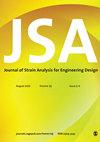用一个变形几何序列完整地描述了大块成形中的断裂成形极限
IF 1.8
4区 工程技术
Q3 ENGINEERING, MECHANICAL
Journal of Strain Analysis for Engineering Design
Pub Date : 2023-07-10
DOI:10.1177/03093247231187015
引用次数: 1
摘要
本文提出了在从单轴压缩到等双轴拉伸的各种应变加载路径下,确定断裂形成极限的打乱几何序列。结合数字图像相关和压缩力随时间的实验演化,得到主应变空间中的断裂应变,并利用应变加载路径的瞬时斜率实现有效应变-应力三轴空间中断裂应变的表示。通过结合Cockcroft-Latham准则和McClintock准则建立的非耦合韧性断裂准则对断裂时的实验应变进行建模,并使用扫描电镜进行断口分析,可以理解和表征剪切和拉伸的裂纹张开模式,以及观察到混合裂纹张开模式的不确定区域。结果证实,用于确定大块成形中断裂成形极限的新打乱几何序列的总体理念和目标类似于板材成形中常用的中岛试验。本文章由计算机程序翻译,如有差异,请以英文原文为准。
A complete characterization of THE fracture forming limits in bulk forming by means of an upset geometry sequence
This paper presents an upset geometry sequence to determine the fracture forming limits in a wide variety of strain loading paths ranging from uniaxial compression to equibiaxial tension. The strains at fracture in principal strain space are obtained by combination of digital image correlation and experimental evolutions of the compression force versus time, and their representation in the effective strain versus stress triaxiality space is accomplished by means of a new analytical framework that uses the instantaneous slope of the strain loading paths. Modeling of the experimental strains at fracture by means of an uncoupled ductile fracture criterion built upon combination of the Cockcroft-Latham and McClintock criteria and fractography analysis using a scanning electron microscope allow understanding and characterizing the crack opening modes by shear and tension as well as the uncertainty region inside which mixed crack opening modes are observed. Results confirm that the overall philosophy and objectives underlying the new upset geometry sequence for determining the fracture forming limits in bulk forming resemble those of the Nakajima test that is commonly used in sheet forming.
求助全文
通过发布文献求助,成功后即可免费获取论文全文。
去求助
来源期刊

Journal of Strain Analysis for Engineering Design
工程技术-材料科学:表征与测试
CiteScore
3.50
自引率
6.20%
发文量
25
审稿时长
>12 weeks
期刊介绍:
The Journal of Strain Analysis for Engineering Design provides a forum for work relating to the measurement and analysis of strain that is appropriate to engineering design and practice.
"Since launching in 1965, The Journal of Strain Analysis has been a collegiate effort, dedicated to providing exemplary service to our authors. We welcome contributions related to analytical, experimental, and numerical techniques for the analysis and/or measurement of stress and/or strain, or studies of relevant material properties and failure modes. Our international Editorial Board contains experts in all of these fields and is keen to encourage papers on novel techniques and innovative applications." Professor Eann Patterson - University of Liverpool, UK
This journal is a member of the Committee on Publication Ethics (COPE).
 求助内容:
求助内容: 应助结果提醒方式:
应助结果提醒方式:


